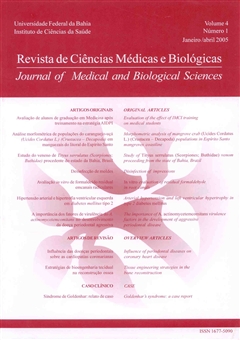Study of Tityus serrulatus (Scorpiones; Buthidae) venom proceeding from the state of Bahia, Brazil
DOI:
https://doi.org/10.9771/cmbio.v4i1.4156Keywords:
scorpion - venom, Tityus, T. serrulatusAbstract
The scorpion Tityus serrulatus is known as the most important species according to the medical point of view, because it is what causes the most serious registered accidents for the Brazilian country. This work deals with the characterization of the poison of scorpion T. serrulatus in different regions of Bahia/Brazil, through the attainment of the DL50 of the poison the determination of pulmonary edema induced for the poison and the characterization of the neurotoxic effects induced by the poison. The poison was obtained through electric stimulation using itself of a extractor (method of Brazil, 1949), developed specifically for this end. Male Swiss mice (18-22g) had been used to evaluate the toxicity for the method of Finney (1971). The pulmonary induction of edema was calculated by the difference of weight of the controlled and tested lung. The obtained DL50 was of 93.6 µg mouse. We can attribute this high value to low toxicity of the poison for the animals of the studied region (Metropolitan Region of Salvador). The observed toxicity was of 3 to 7 times lower than that the poison of the same species in other regions of Brazil (São Paulo and Minas Gerais). Our results in the performed experiments to study acute lung edema had demonstrated that the poison of T. serrulatus of the State of the Bahia does not induce death.Downloads
Download data is not yet available.
Downloads
Published
2005-01-02
How to Cite
Silva, T. F. da, Silva, L. L. C. e, Barbosa Júnior, A. de A., & Silva, R. M. L. da. (2005). Study of Tityus serrulatus (Scorpiones; Buthidae) venom proceeding from the state of Bahia, Brazil. Journal of Medical and Biological Sciences, 4(1), 24–31. https://doi.org/10.9771/cmbio.v4i1.4156
Issue
Section
ORIGINAL ARTICLES
License
The Journal of Medical and Biological Sciences reserves all copyrights of published works, including translations, allowing, however, their subsequent reproduction as transcription, with proper citation of source, through the Creative Commons license. The periodical has free and free access.


